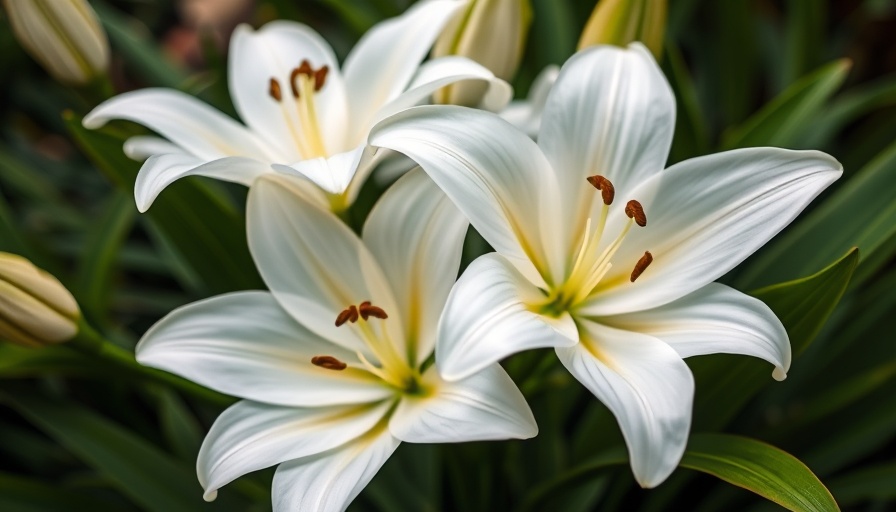
Why Easter Lilies Are Essential for Your April Garden
Easter lilies are not merely beautiful; they carry deep cultural significance, symbolizing renewal and hope, a perfect theme for spring. These elegant flowers have an undeniable presence in gardens, effortlessly enhancing the scenery with their bright and fragrant blooms. As we open the door to April, explore how choosing the right varieties of Easter lilies can transform your outdoor space into a flourishing display of color and life.
Discover Stunning Varieties of Easter Lilies
Among the varieties available, three stand out due to their unique charm and growth habits. Each lily brings its own gift to the garden and provides different aesthetics and benefits:
1. White Elegance Lily: This classic favorite is not just about beauty; it embodies the spirit of serenity in any landscaping. White elegance can reach up to 3 feet tall, making it suitable for borders and classic arrangements. Its broad, trumpet-shaped blooms release a calming fragrance that creates peaceful settings. When paired with pastel flowers like tulips or daffodils, it cultivates an elegant garden backdrop.
Key benefits include:
- Produces a calming fragrance perfect for peaceful ambiance.
- Pairs seamlessly with various spring flora.
- Strong stems lend support, allowing for multiple blooms.
2. Pink Perfection Lily: With its vibrant, deep pink blooms that can grow up to 6 inches in diameter, the pink perfection lily is a springtime superstar. This variety blooms mid-April and emits a sweet scent that attracts pollinators, enhancing your garden's biodiversity. Placing pink perfection in the background allows it to serve as a majestic backdrop for smaller flowers while providing stunning visual interest.
Benefits of pink perfection include:
- Striking trumpet-shaped blooms add vibrant color.
- Excellent height for visual interest and pollinator attraction.
3. Golden Splendor Lily: For those who appreciate warmth in their gardens, the golden splendor lily grows up to 5 feet tall and thrives in full sun. Its golden hue adds a touch of sunshine to any flower bed, making it an impressive statement piece.
Notable aspects include:
- Height provides a dramatic focal point in any landscape.
- Colors enhance the warmth and vibrancy of the garden.
How to Care for Your Easter Lilies
When planting Easter lilies, consider the following care tips to ensure they flourish:
- Location: Choose a planting site that receives ample sunlight, especially for varieties like the golden splendor, which loves the sun.
- Soil Quality: Ensure well-draining soil to prevent waterlogging, which can damage the bulbs.
- Watering: During the growth phase, keep the soil consistently moist; however, avoid overwatering.
- Fertilization: Apply a balanced fertilizer during the growing season to stimulate robust growth and blooming.
Explore Combinations: Integrating Easter Lilies with Other Plants
Integrating Easter lilies with diverse flora can create truly striking landscapes. Consider the color palettes and fragrances of your chosen flowers:
- Combine white elegance with pale pinks and blues to create a soft pastel garden motif.
- Use the bright pink perfection against lush green backdrops or white blossoms for a vibrant contrast.
- Plant golden splendor near darker foliage for a dramatic effect that draws the eye.
Future Trends: What’s Next for Garden Design?
As gardening trends continue to evolve, more homeowners are embracing eco-friendly practices. Choosing native lilies and other regional flowers can provide sustenance for local wildlife and contribute to biodiversity. As you plan your garden, look for sources that emphasize sustainable gardening techniques.
Concluding Thoughts on Growing Easter Lilies
The secret to a dazzling garden lies in choosing the right plant varieties and caring for them effectively. Easter lilies are an exquisite option that embodies beauty and context, bringing a floral elegance that resonates deeply. Whether you’re planting for personal joy or to create a captivating outdoor aesthetic, embracing these flowers can lead to a rewarding gardening experience.
Start your spring planting journey today and watch your garden bloom with life, color, and meaning! Embrace the season of renewal by growing Easter lilies that not only beautifies your surroundings but also symbolizes hope and rebirth in your personal spaces.
 Add Row
Add Row  Add
Add 




Write A Comment